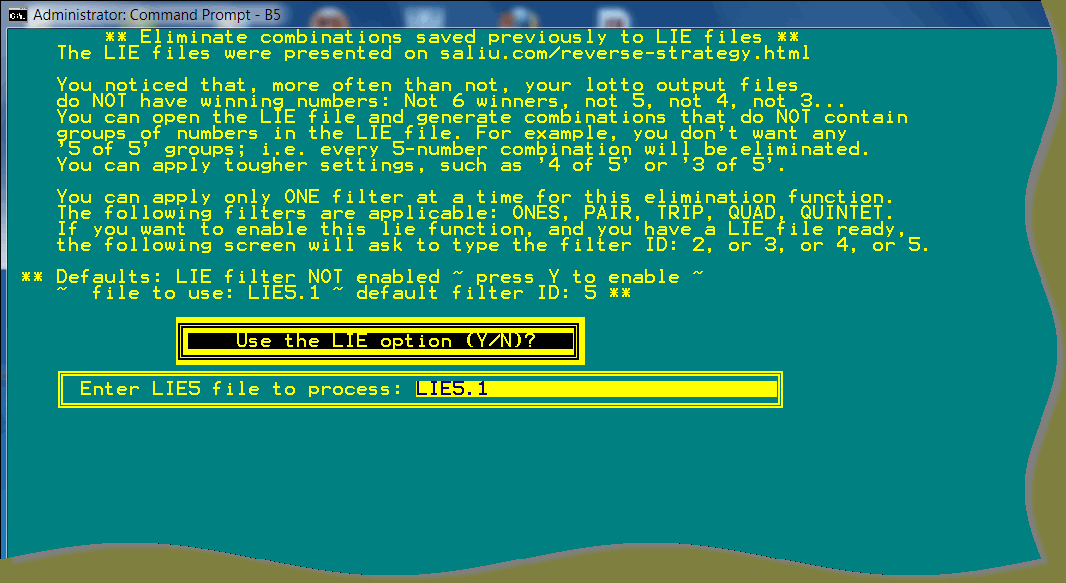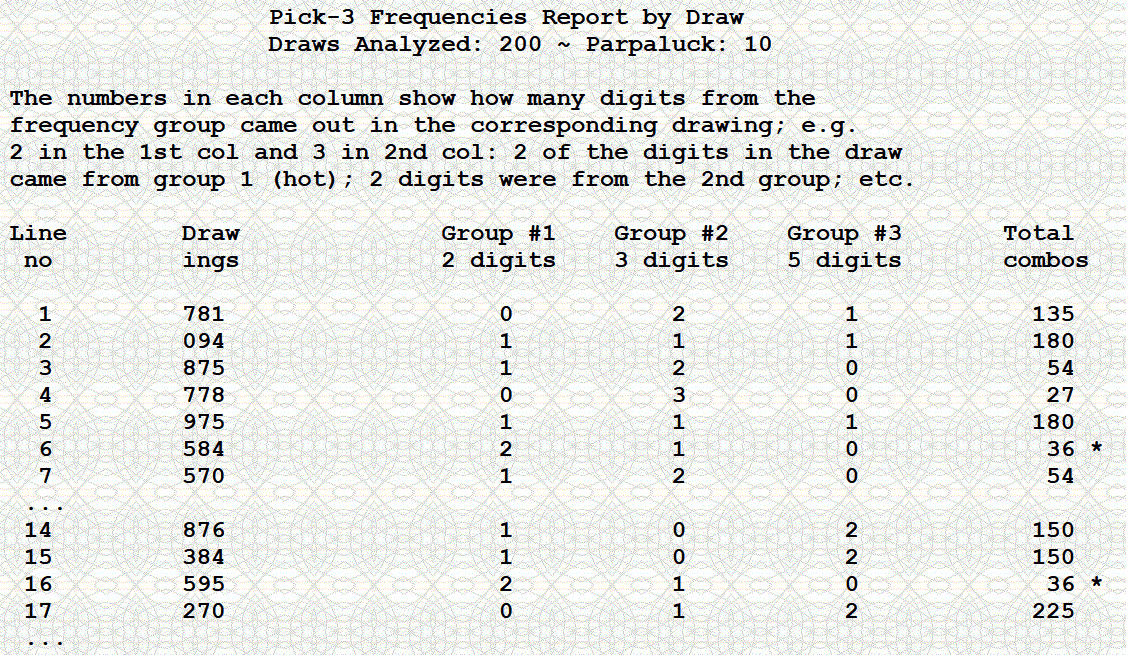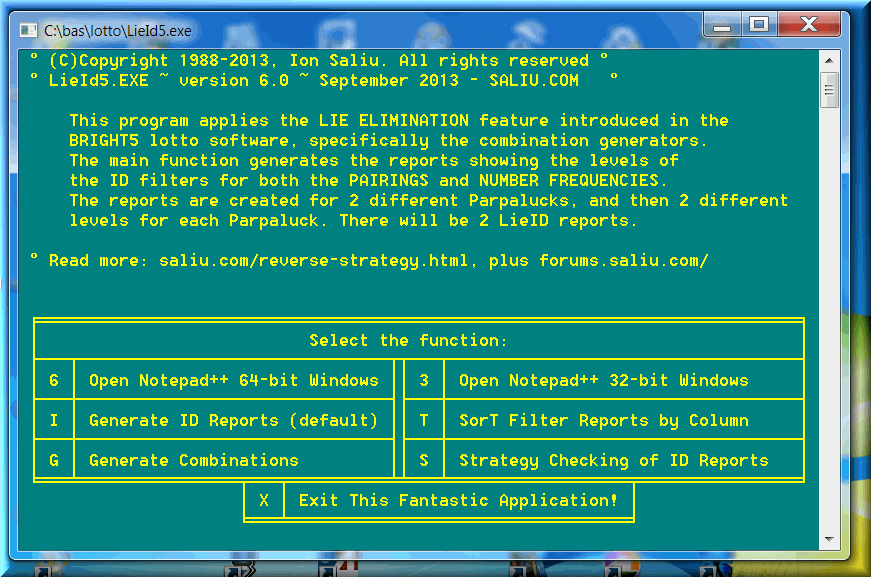
Lotto, Lottery Strategy in Reverse: Not-to-Win Leads to Not-to-Lose or WIN
★ ★ ★ ★ ★
By Ion Saliu, Strategist At-Large





I stumbled upon some old papers. The documents described old pick-3 lottery strategies. I remember I worked them out together with a good lottery collaborator in California. Funny, the output files were named LIE.3, LIE.4… Then, reminders to me on pieces of paper: “The filter TOT always purges LIE.3 pick lottery files. The lotto filter ANY always purges LIE files generated by ANY and SUM.”
The strategy was, in fact, a lottery strategy in reverse! I wanted to select lottery filters making sure I set them wrong! For example, I would set VR_1 = 5 and VR_2 = 5. The pick-3 strategy worked if VR_1 was less than 5 and VR_2 was less than 5 the very next draw.
The output generated by the two filters (a file I named LIE) would be added to the D3 file (on top). I would eliminate all the lotto combinations in that LIE file, because I knew they wouldn't hit! I would select some 25-30 filters that way. On many occasions, I would be wrong in the case of just one filter! That is, out of 30 pick-3 lottery filters I wanted to be wrong, I would set one of them correctly! Therefore, the whole lottery strategy would fail! Make sense?

It is a longer story that I wrote about in my previous lotto forum and also in my 2010 lottery Super Forums. Several members of the forums participated in the discussion. That discussion contributed also to the most significant upgrade of my lotto-5 software: Bright5.
I will repost here the most important parts of the analyses of the new strategy (also known as LIE) that is also a feature (function) of my latest lotto software.
The LIE name for the lottery strategy and the files sounds curious. The better one I had was NOT files. As in that output file will NOT have winners the next lottery drawing. Problem was NOT is a widely used keyword in computer programming. That's why I chose LIE — still a short word with similar significance. As in if that output file will hit in the next lottery drawing, that will be a LIE.
It is one of the fundamental laws of logic: The negation of negation is affirmation. And that's how my reversed lottery strategy took off.
You noticed that, more often than not, your lotto output files do NOT have winning numbers: Not 6 winners, not 5, not 4, not 3n ot even 2 at times. You can open the LIE file and generate lotto combinations that do NOT contain groups of numbers in the LIE file. For example, you don't want any '5 of 5' groups; i.e. every 5-number combination will be eliminated. You can apply tougher settings, such as '4 of 5' or '3 of 5', even '2 of 5'. You can apply only ONE filter at a time for this elimination function. The following filters are applicable: ONE, PAIR, TRIP, QUAD, QUINTET (6-number lotto).
The LIE option (reversed lottery strategy) is implemented in the following lotto software packages: Bright5.exe and Bright6. Also in the pick lottery software collections Bright3 and Bright4.exe; and in the horse racing software BrightH3. By default, the LIE filter is NOT enabled — the user has to press Y/y (for Yes) to enable it.

I ran Combine5-10 with the LIE option against LIE5.2. The filter ID=2 generated 12 combinations. One of the combos had 3 winners. I had expected 5 of 5. I looked up carefully TOP5. One of the numbers that was not drawn was top-10-paired with 3 of the numbers in the drawing:
5 3 16 10 13 1 19 33 34 40 42
That was a real bad situation! In my logic, I did not expect more than one of the lotto numbers in the drawing be top-10 paired with any other number in the game! For example, just 5 and 3 being top-10 pairings would have been OK.
I repeated the procedure for the other situation:
Drawing #203: 12, 24, 25, 37, 38
The filter ID = 2 generated just one combination, which also had 3 winners. I checked TOP5 again:
15 38 32 24 30 31 1 36 22 39 41
20 30 42 27 5 32 37 24 13 14 15
I tried ID = 3 and it generated the jackpot combination, but in over 45,000 combinations! On the other hand, 45,000 represent just fewer than 5% of total 5-43 lotto combinations. In other words, the LIE filter eliminated 95% of total combinations, with just one LIE file, and with a good frequency.
We are not limited to pairings only. We run the combination generators in Super Utilities (normally without favorite numbers). We can enable the Least Triples with Least53 as input. We know now for sure that the output will NOT have the jackpot combination the very next lottery drawing. It is very rare to get just 3 winning numbers in the output. That output file also is a very good candidate for the LIE function. The same goes for Quadruples and Least54 as input.

The main focus was pick 3 lottery, clarifying intentional misunderstanding by a member (and also sore competitor).
I plotted 3 reports for pick-3. You can see that some 3-parameter strings (1-0-2, etc.) do not repeat for a few drawings; other strings do repeat more often than others. You can see that the 1-1-1 type of strings show better frequencies.
LOWER frequency: Good candidate for LIE;
HIGHER frequency: Good candidate for PURGE (as in playing straight, not in reverse).

I generate combinations to one output file (LIE3.1 or just OUT3.1) for the decade string 1-0-2 (the 1st line in the report). Straight sets generated: 81.
I generate combinations to one output file (LIE3.2 or just OUT3.2) for the frequency string 0-2-1 (the 1st line in the report). Straight sets generated: 135.
I generate combinations to one output file (LIE3.3 or just OUT3.3) for the low/high string 2-2-1 (the 1st line in the report). Straight sets generated: 125.
I generate combinations to one output file (LIE3.4 or just OUT3.4) for the odd/even string 1-2-1 (the 1st line in the report). Straight sets generated: 100.
I can concatenate to a LIE3 file of 441 combosnations (there are some duplicates). There is a good chance I will be successful quite often. Of course, the LIE feature is an addition to other filters, part of a pick-3 strategy.

You could see in the frequency report two occurrences of an obvious pick-3 strategy. They are marked by * (lines #6 and #16). The frequency string 2-1-0 always generates 36 combinations (different from draw to draw, usually). If played in the last 20 draws, the cost would be 720. An online lottery would pay 1800. The strategy occurs 10-12 times in 200 drawings. The cost of 7200 would yield 9000.
The strategy has also skips — thus, a number of drawings will NOT be played. There are also other filters to apply. The LIE strategy can be also applied at the same time.
An even tighter strategy occurs 2-4 times in 200 drawings: 3-0-0 (frequency groups). It generates 8 combinations. That strategy can hardly be reduced to fewer combinations. But 50 drawings can be skipped between hits. The cost would be 8 * 100 = 800. The online lotteries would pay 1800.
~ 2: Purge output files
In this real-life case, we generate the 36 pick 3 sets to a traditional output file (e.g. OUT3). We select Purge in the Lexico.exe programs. We enter the normal lottery data file (D*). Then, we enter OUT* as file to purge. Finally, we can apply one or more LIE* files.
If we create LIE files that work with different filter IDs, we can use the power of the PURGE function available in the lexicographical generators: Lexico5.exe and Combine5-10. For example, we start with LIE5.1 and generate (in normal lexicographic mode) an output file OUT5.L1. Next, we apply the LIE5.2 and run PURGE against OUT5.L1 ... and so on.
~ 3: Reversed strategy
There are lots of possibilities for the new LIE function. We have also plenty — I mean, lots — of filters to work with! Not to mention we have the strategy checking utilities. I guess we need some extra patience and diligence too.
Additionally, more than one LIE file can be created to work with the same filter ID. And, of course, there are many other lotto filters to work with the traditional lottery strategy manner.
It is important, however, the filter ID to enable when applying the LIE function. Also, we can concatenate several LIE files where we can apply the same filter ID. Use the special concatenation function in the menu facility of Bright lottery packages.
Preserve your lottery output files. You might want to concatenate some of them. Checking for winners is another useful tool in Super Utilities. We can run also Winners, the standalone program that checks for winning numbers against real lottery drawings. We can notice that a large output file doesn't hit even 2 winning lotto numbers at times. Make it a LIE file — and apply the specific filter ID!

"Tell me lies...
Tell me sweet little lies..."


Home | Search | New Writings | Fundamental Formula | Odds, Generator | Contents | Forums | Sitemap
